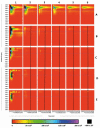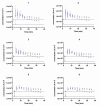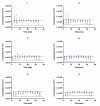SARS-CoV-2: characterisation and mitigation of risks associated with aerosol generating procedures in dental practices
- PMID: 33414544
- PMCID: PMC7789077
- DOI: 10.1038/s41415-020-2504-8
SARS-CoV-2: characterisation and mitigation of risks associated with aerosol generating procedures in dental practices
Erratum in
-
Correction to: SARS-CoV-2: characterisation and mitigation of risks associated with aerosol generating procedures in dental practices.Br Dent J. 2021 Feb;230(3):169. doi: 10.1038/s41415-021-2665-0. Br Dent J. 2021. PMID: 33542490 Free PMC article. No abstract available.
Abstract
Introduction The objectives were to characterise the particle size distribution of aerosols generated by standard dental aerosol generating procedures (AGPs) and to assess the impact of aerosol-management interventions on 'fallow time'. Interventions included combinations of high-volume intraoral suction (HVS[IO]), high-volume extraoral suction (HVS[EO]) and an air cleaning system (ACS).Method A sequence of six AGPs were performed on a phantom head. Real-time aerosol measurements (particle size range 0.0062-9.6 μm) were acquired from six locations within a typical dental treatment room (35 m3).Results The majority (>99%) of AGP particles were <0.3 μm diameter and remained at elevated levels around the dental team during the AGPs. With no active aerosol-management interventions, AGP particles were estimated to remain above the baseline range for up to 30 minutes from the end of the sequence of procedures.Conclusions The results emphasise the importance of personal protection equipment, particularly respiratory protection. Use of HVS(IO), either alone or in combination with the ACS, reduced particle concentrations to baseline levels on completion of AGPs. These data indicate potential to eliminate fallow time. The study was performed using a phantom head so confirmatory studies with patients are required.
Conflict of interest statement
The authors have not declared any conflict of interest. Techceram Ltd is a commercial entity in the dental field, but has no interest in any of the equipment used in the present study, only in contributing its network of contacts towards the present study, in order to better understand dental AGPs, so that dental hospitals, practices, labs and associated dental supply chain smaller businesses can remain open and operate safely through any future viral pandemics.
Figures






Comment in
-
A breath of fresh air.Br Dent J. 2021 Mar;230(5):305. doi: 10.1038/s41415-021-2813-6. Br Dent J. 2021. PMID: 33712781 Free PMC article. No abstract available.
-
Author Q&A: Ian Jenkinson.Br Dent J. 2021 Mar;230(5):305. doi: 10.1038/s41415-021-2814-5. Br Dent J. 2021. PMID: 33712782 Free PMC article. No abstract available.
Similar articles
-
Simulated and clinical aerosol spread in common periodontal aerosol-generating procedures.Clin Oral Investig. 2022 Sep;26(9):5751-5762. doi: 10.1007/s00784-022-04532-8. Epub 2022 May 17. Clin Oral Investig. 2022. PMID: 35581347 Free PMC article.
-
Aerosol reduction efficacy of different intra-oral suction devices during ultrasonic scaling and high-speed handpiece use.BMC Oral Health. 2022 Sep 6;22(1):388. doi: 10.1186/s12903-022-02386-w. BMC Oral Health. 2022. PMID: 36068515 Free PMC article.
-
Real-time Monitoring of Aerosol Generating Dental Procedures.J Dent. 2022 May;120:104092. doi: 10.1016/j.jdent.2022.104092. Epub 2022 Mar 16. J Dent. 2022. PMID: 35304203
-
Interventions to reduce contaminated aerosols produced during dental procedures for preventing infectious diseases.Cochrane Database Syst Rev. 2020 Oct 12;10(10):CD013686. doi: 10.1002/14651858.CD013686.pub2. Cochrane Database Syst Rev. 2020. PMID: 33047816 Free PMC article.
-
A Review of Aerosol Generation Mitigation in International Dental Guidance.Int Dent J. 2022 Apr;72(2):203-210. doi: 10.1016/j.identj.2021.04.002. Epub 2021 Jun 3. Int Dent J. 2022. PMID: 34090684 Free PMC article. Review.
Cited by
-
Efficacy of Aerosol Reduction Measures for Dental Aerosol Generating Procedures.Aerosol Sci Technol. 2022;56(5):413-424. doi: 10.1080/02786826.2022.2040729. Epub 2022 Mar 1. Aerosol Sci Technol. 2022. PMID: 36311996 Free PMC article.
-
Dispersion of Aerosols Generated during Dental Therapy.Int J Environ Res Public Health. 2021 Oct 27;18(21):11279. doi: 10.3390/ijerph182111279. Int J Environ Res Public Health. 2021. PMID: 34769795 Free PMC article. Review.
-
Restoration of dental services after COVID-19: The fallow time determination with laser light scattering.Sustain Cities Soc. 2021 Nov;74:103134. doi: 10.1016/j.scs.2021.103134. Epub 2021 Jul 9. Sustain Cities Soc. 2021. PMID: 34540565 Free PMC article.
-
Efficacy of dental evacuation systems for aerosol exposure mitigation in dental clinic settings.J Occup Environ Hyg. 2022 May;19(5):281-294. doi: 10.1080/15459624.2022.2053140. Epub 2022 Apr 6. J Occup Environ Hyg. 2022. PMID: 35289720 Free PMC article.
-
Bioaerosols and Airborne Transmission in the Dental Clinic.Int Dent J. 2024 Nov;74 Suppl 2(Suppl 2):S418-S428. doi: 10.1016/j.identj.2024.09.026. Int Dent J. 2024. PMID: 39515929 Free PMC article. Review.
References
-
- Bogdan A, Buckett M I, Japuntich D A. Nano-sized aerosol classification, collection and analysis -method development using dental composite materials. J Occup Environ Hyg 2014; 11: 415-426. - PubMed
-
- Day C J, Price R, Sandy J R, Ireland A J. Inhalation of aerosols produced during the removal of fixed orthodontic appliances: a comparison of 4 enamel cleanup methods. Am J Orthod Dentofacial Orthop 2008; 133: 11-17. - PubMed
-
- Micik R E, Miller R L, Mazzarella M A, Ryge G. Studies on dental aerobiology. I. Bacterial aerosols generated during dental procedures. J Dent Res 1969; 48: 49-56. - PubMed
-
- WHO. Infection prevention and control of epidemic- and pandemic-prone respiratory infections in health care. 2014. Available at https://apps.who.int/iris/bitstream/handle/10665/112656/9789241507134_en... (accessed November 2020). - PubMed
Grants and funding
LinkOut - more resources
Full Text Sources
Other Literature Sources
Miscellaneous

